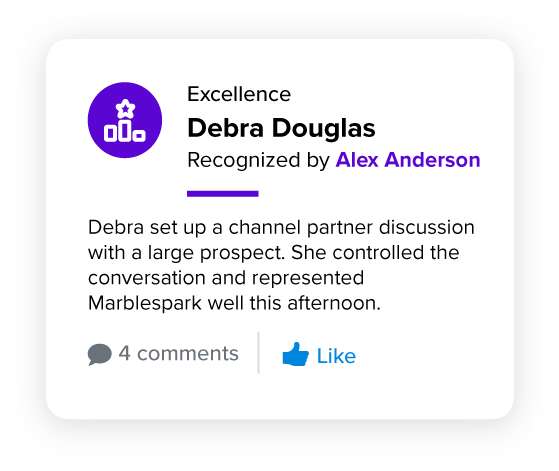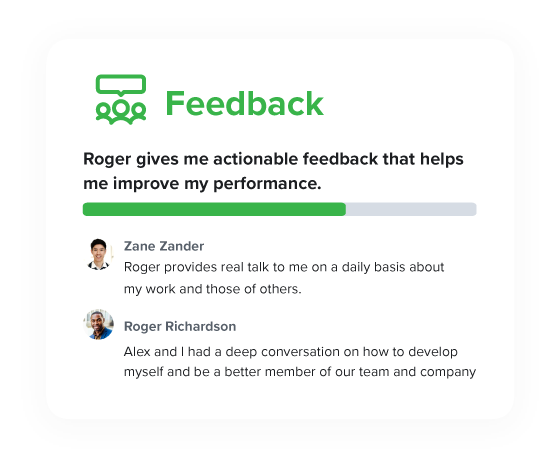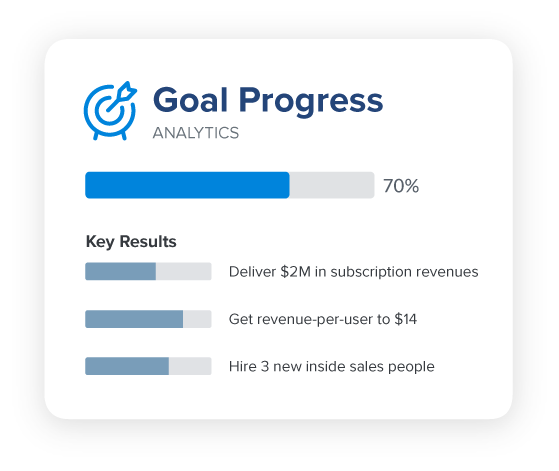Check out the other tools in our performance management suite designed to help you and your managers grow, develop, and align your teams to maximize success.
PERFORMANCE REVIEW SOFTWARE
A flexible performance review system that saves time and sparks action.
Performance reviews don’t have to be a disjointed, logistical nightmare as your organization scales. We help make your process seamless and efficient—equipping your teams with the insights and tools they need for meaningful conversations that promote continuous improvement.

PERFORMANCE REVIEW TOOLS
Simplify and scale your process so everyone has impactful performance reviews
Performance conversations don’t need to be hard. Easily set up and tailor our employee performance review software to fit your growing teams – your process, your way. Focus your teams on having more impactful conversations (rather than time-consuming prep work) with AI-powered tools and insights they can act on.
Customize our employee review software to fit your unique needs
When it comes to employee evaluation, one size does not fit all. Easily measure what you want, when you want with flexible review modules that you can tailor to fit your needs. Use one template across your entire organization or build multiple to meet the needs of various groups.
- Goal ratings: Embed specific goals and ratings into reviews
- Competencies: Include your unique competencies and skills
- Weighting: Choose how to weight each module in your review
- Scales: Select the alpha or numeric scale that works best
- Questions: Add other custom questions to your template


Seamlessly integrate performance reviews into your broader performance management program
Reviews work better when they're connected to your other performance management features. We work with you to build a process that works for your organization's needs.
Not sure where to start? Check out our Performance Pathways for ready-to-use (but still customizable) frameworks that make it easy to launch or evolve your program.
Simplify and automate your review cycles to save valuable time
With automated invites and reminders, let technology handle the administrative tasks—so you don’t have to. Get a fast, easy-to-implement performance review software that ensures timely feedback, reduces manual effort and drives efficiency from day one.


Easily aggregate and summarize performance data for more insightful review conversations
✨Ask AI helps your managers and employees reference past performance data directly within annual reviews. And we make it easy to pull in context from 1-on-1s, goals, recognition, talent reviews, and performance feedback.
As your teams engage in performance activities throughout the year, they'll benefit from richer data, context, and insight. This helps managers and employees easily pull together review content, reduces recency bias, and personalizes each conversation.
Facilitate stress-free, meaningful, performance conversations with the help of AI
Managers notoriously hate employee performance evaluations, and HR lives in constant fear of what they might say. Our AI-assisted workflows flip the status quo on its head and make writing clear, succinct, and constructive feedback easy.
- ✨Writing Assistant: improve the clarity, brevity, and tone of feedback at each step of the review writing process.
- ✨Summary Assistant: pull all feedback together—and generate suggested actions—to create an actionable plan for employees after the review.
Try our AI-powered Summary Assistant for free >>


Visualize and align on organization-wide performance data to guide your talent development strategy
Get a comprehensive view of your organization’s talent management program to identify high and low performers with our talent dashboard. Zoom out and see the big picture, to help you make more informed decisions on employee growth and how to keep and develop your best talent.
Easily track response rates and other review analytics
You need to make sure the habits you build stick. Easily track the status of each review cycle to help team members stay accountable and monitor performance ratings in real-time. Robust administration tools let you adjust active cycles as needed.

Find out why customers love our performance evaluation software
“Quantum Workplace has given us the means to measure what we have not previously been able to measure formally: how focused our teams are on regular formal communication, goal setting, and consistent recognition. Without a doubt, Quantum Workplace has been a critical benefit to enhancing the employee experience at Scooter’s Coffee.”
Patty Nash
Employee Experience Advisor
at Scooter's Coffee
Annual Performance Review Software FAQs
What is a performance review?
A performance review is a formal evaluation of an employee's performance, skills, and accomplishments in their job. While reviews serve as an opportunity for managers and employees to discuss performance, set goals, provide feedback, and recognize accomplishments, the current state of performance reviews has faced numerous challenges. A modern performance review should be a two-way, individualized conversation between a manager and an employee about performance impact, development, and growth. It is a critical component of an organization’s overall performance management process and performance management system. How an organization navigates performance review conversations has a demonstrated impact on employee engagement and retention.
Why should we care about performance reviews?
Performance reviews are helpful for understanding progress and areas of improvement for each employee. They help employees see where they're doing great, where they can get better, and what they should aim for next. If wielded well, performance reviews can be a secret weapon in retaining top performers. They serve as a perfect opportunity to summarize an employee's progress, recognize contributions, and develop a growth plan that is aligned with your organization's vision and key objectives.
What should I look for in a performance evaluation system?
When selecting performance review software, it’s crucial to consider features that align with your organization’s culture, simplify the evaluation process, and enhance the objectivity of feedback. Here’s what you should look for:
- Customizability: Look for flexible performance review templates and scheduling that can be tailored to various performance management cycles and your organization's needs. This includes the ability to adapt features such as goal ratings, competencies, weighting, rating scales, and custom performance review questions to fit your specific requirements. A platform that allows for different templates across various groups within your organization ensures that the reviews are relevant and resonate with all departments.
- Simplicity and Usability: Look for a platform that is easy to use for both HR teams and end users, including managers and employees. The interface should be intuitive, reducing the administrative burden and making it easier to conduct your employee review process. Features like automated workflows, clear tracking of review statuses, and straightforward analytics help keep everyone accountable and informed throughout the review process.
Additionally, consider how good performance review software facilitates effective performance conversations and performance review best practices:
- Embedded Analytics and Data: Effective performance review software should provide leaders with analytics that help them analyze and act on key performance insights. This includes tracking response rates, review completion statuses, and comprehensive performance data which should be easily accessible and interpretable to inform decisions.
- Support for Objective Feedback: Employee performance appraisal systems should support mechanisms that promote objectivity in reviews, such as employee goals, 360-degree feedback, and multi-rater reviews. These features help gather diverse perspectives and reduce biases, making the feedback more comprehensive and valuable.
By focusing on these aspects, you can choose performance review software that not only fits your organizational culture but also enhances the effectiveness and fairness of your performance evaluations.
What makes Quantum Workplace’s performance appraisal tool different?
Administering effective and objective performance reviews across your entire organization requires a partner you can rely on. For the last 20+ years, our customers have trusted us to deliver reliable expertise, technology, service and results.
We help you uncover meaning.
Understand what's truly driving or hindering employee performance, engagement, and retention. Keep your people on the same page with formal performance reviews using our validated best practices.
We make action easy for everyone.
Performance reviews need to be easy for everyone. Our solutions help reduce headaches for HR professionals, integrate into manager workflows, and encourage employee involvement.
We’re a partner you can rely on.
You’re on a journey – and we’re with you every step of the way. You can rely on our dedicated team to provide strategic guidance, ongoing coaching, timely tech support, and safe and secure practices your programs need to be successful.
PERFORMANCE MANAGEMENT SOFTWARE
Every tool you need to inspire employee impact and performance.
Recognition

Motivate employees and celebrate success with real-time recognition. Easily share stories of success across your organization.
Feedback

Boost employee performance, growth, and development with 360, peer, upward feedback, and more. Support a culture of continuous feedback.
Goals

Move teams forward with clear and aligned goals that drive results. Set, track, and accomplish important goals.
1-on-1s

Empower meaningful conversations at every level, across any department. Increase communication, clarity, and engagement.
Empower your managers and teams to drive impact.
Explore Quantum Workplace’s performance management platform today.



